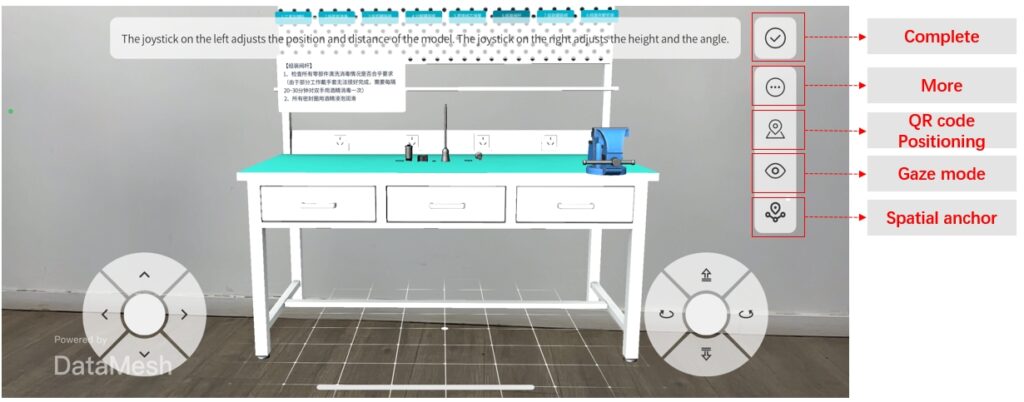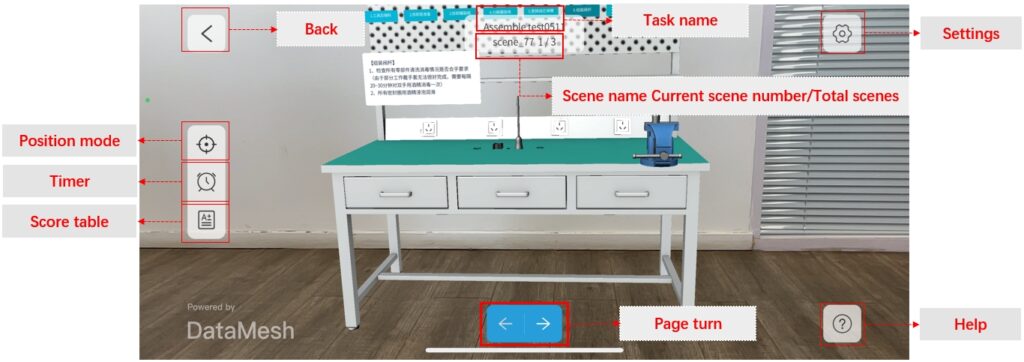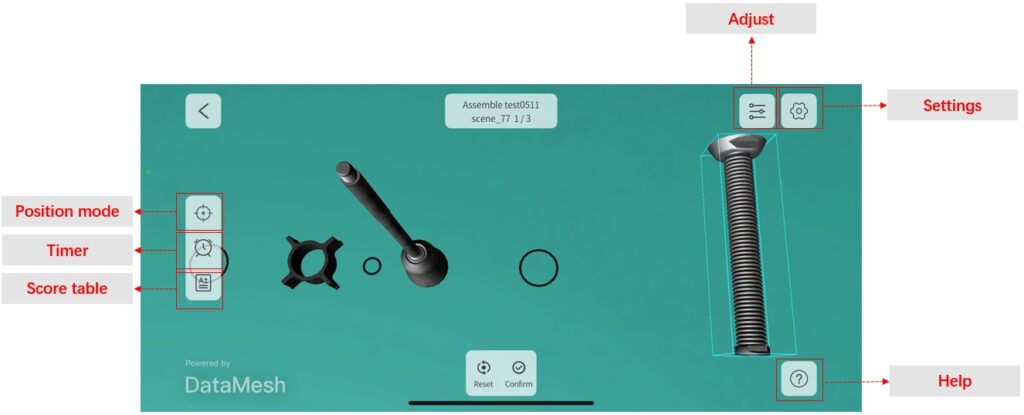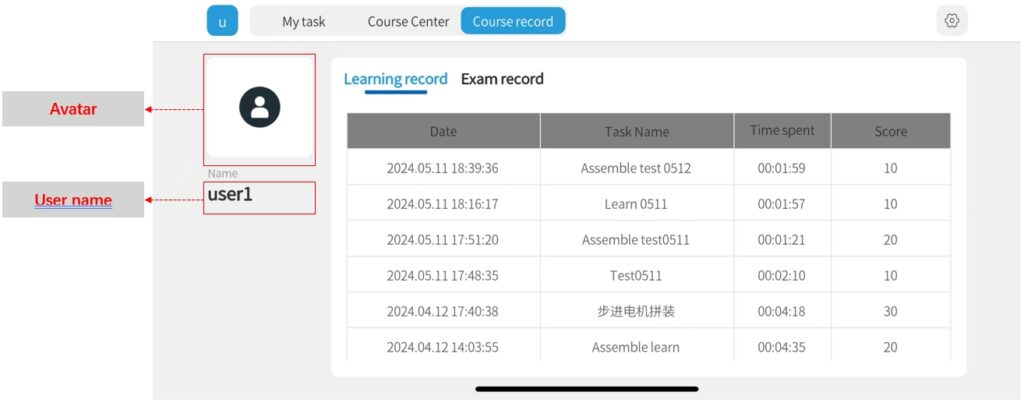How Can We Help?
Training mode
This chapter will provide a detailed overview of the user interface and numerous features of DataMesh One in training mode. You’ll learn how to use DataMesh One in training mode, including the processes to design learning and test tasks by instructors, as well as the procedures followed by students to complete these learning and test tasks.
User interface
Main interface
The main interface of DataMesh One in training mode is as follows:

My Tasks: The My Tasks page displays a list of all learning tasks and test tasks.
Course record: The Course record shows all learning records and test records, including time, task names, duration, and scores.
Settings
The Settings for the training mode interface are the same as those for the standard mode. For more details, refer to the section Settings under standard mode.
Resource positioning

The side buttons in the Position Mode interface support the following actions:
-
- Complete positioning adjustments: Click the Complete button to exit Positioning Mode and enter the scene playback interface.
- Adjust displacement and rotation precision: You can open the additional features panel by clicking the More Options button
 and then click the setting button
and then click the setting button  to enter the Set click accuracy window for refining the precision of displacement and rotation.
to enter the Set click accuracy window for refining the precision of displacement and rotation. - QR code Positioning: Click the QR code Positioning button
 to use the scan-based positioning feature for a more accurate positioning of the scenario.
to use the scan-based positioning feature for a more accurate positioning of the scenario. - Gaze Mode: Click the gaze mode button
 to enter the Gaze Mode, adjust the scenario’s position by moving the camera’s field of view.
to enter the Gaze Mode, adjust the scenario’s position by moving the camera’s field of view.
For more details, please refer to the section Resource positioning under standard mode.
Learning tasks

Task Status
-
- Incomplete: Tasks that have not been started or have not been completed are considered incomplete.
- Completed: Tasks that have been completed within the task period.
- Expired: Tasks that exceed the task deadline are considered expired tasks.
Playback interface of the learning task

The side buttons in the playback interface of the learning task support the following actions:
-
- Settings: Click the settings button
 to open the settings page for configuration.
to open the settings page for configuration. - View task timer: If the task has set a task duration, clicking the timer button
 will display the remaining time until the learning task ends. If the duration is exceeded, the task will automatically end.
will display the remaining time until the learning task ends. If the duration is exceeded, the task will automatically end. - View task score: Click the task score button
 to see the real-time task scoring situation.
to see the real-time task scoring situation. - Switch to position mode: Click the position mode button
 to enter the position mode for adjusting the scenario’s position.
to enter the position mode for adjusting the scenario’s position. - Help: Provide concise operating instructions and relevant tips to help you better understand and use the features.
- Settings: Click the settings button
Interaction interface of the learning task
The interaction interface of the learning task appears as follows:

You will find the Skip, Demo, Reset, and Confirm buttons below the interaction interface:
-
- Demo: Clicking the Demo button allows you to watch the correct way for roles to interact.
- Reset: Clicking the Reset button restores the model to its state before being moved.
- Confirm: After placing the interactive role in the correct position and rotating it to the proper angle, clicking the Confirm button completes the interaction.
- Skip: Clicking the Skip button lets you directly skip the interaction task for the current scene.
The side buttons in the interaction scene of the learning task support the following actions:
-
- Settings: Click the settings button
 to access the general settings.
to access the general settings. - View task timer: If the task has set a task duration, clicking the timer button
 will display the remaining time until the learning task ends. If the duration is exceeded, the task will automatically end.
will display the remaining time until the learning task ends. If the duration is exceeded, the task will automatically end. - View task score: Click the task score button
 to see the real-time task scoring situation.
to see the real-time task scoring situation. - Switch to position mode: Click the position mode button
 to enter position mode and adjust the position.
to enter position mode and adjust the position. - Switch interaction method: Click
 to choose the input type, turn the scene axis on or off, and adjust the scene opacity, and the scene scale ratio.
to choose the input type, turn the scene axis on or off, and adjust the scene opacity, and the scene scale ratio. - Help: Provide concise operating instructions and relevant tips to help you better understand and use the features.
- Settings: Click the settings button
Exam tasks

Task Status
-
- Incomplete: Tasks that have not been started or have not been completed are categorized as incomplete tasks.
- Completed: Tasks that have been completed within the task period by learners.
- Expired: Tasks that exceed the task deadline are considered expired tasks.
Playback interface of the exam task

The side buttons in the playback interface of the exam task support the following actions:
-
- Settings: Click the settings button
 to open the settings page for configuration.
to open the settings page for configuration. - View task timer: If the task has set a task duration, clicking the timer button
 will display the remaining time until the learning task ends. If the duration is exceeded, the task will automatically end.
will display the remaining time until the learning task ends. If the duration is exceeded, the task will automatically end. - View task score: Click the task score button
 to see the real-time task scoring situation.
to see the real-time task scoring situation. - Switch to position mode: Click the position mode button
 to enter the position mode for adjusting the scenario’s position.
to enter the position mode for adjusting the scenario’s position. - Help: Provide concise operating instructions and relevant tips to help you better understand and use the features.
- Settings: Click the settings button
Interaction interface of the exam task
The interaction interface of the exam task appears as follows:

You will find the Reset, and Confirm buttons below the interaction interface:
-
- Reset: Clicking the Reset button restores the model to its state before being moved.
- Confirm: After placing the interactive element in the correct position and rotating it to the proper angle, clicking the Confirm button completes the interaction. Note: If there are multiple interactive elements in the scene, you need to click Confirm after completing each operation for the scoring to take effect.
The side buttons in the interaction scene of the learning task support the following actions:
-
- Settings: Click the settings button
 to access the general settings.
to access the general settings. - View task timer: If the task has set a task duration, clicking the timer button
 will display the remaining time until the learning task ends. If the duration is exceeded, the task will automatically end.
will display the remaining time until the learning task ends. If the duration is exceeded, the task will automatically end. - View task score: Click the task score button
 to see the real-time task scoring situation.
to see the real-time task scoring situation. - Switch to position mode: Click the position mode button
 to enter position mode and adjust the position.
to enter position mode and adjust the position. - Switch interaction method: Click
 to choose the input type, turn the scene axis on or off, and adjust the scene opacity, and the scene scale ratio.
to choose the input type, turn the scene axis on or off, and adjust the scene opacity, and the scene scale ratio. - Help: Provide concise operating instructions and relevant tips to help you better understand and use the features.
- Settings: Click the settings button
Score interface

Course record
The Course record page displays the user’s name, custom avatar, learning records, and exam records.

-
- Avatar: Users can upload a custom avatar on the FactVerse platform.
- User Name: For external users, the name is displayed upon login; for internal users, the username is displayed.
- Learning/Exam Records:
- Time: Displayed in ascending order of completion time; format is yyyy.mm.dd hh:mm, for example, 2022.02.02 12:23.
- Task Name: Displays the name of the learning or exam task.
- Time Taken: Format is hh:mm:ss.
- Score: Shows the final score for a task.
Training Process
Training preparation
Create task assessment scenarios
Training instructors use DataMesh Studio to create scenarios with task assessments. The following is the basic process for creating scenarios with task assessments:
1. Upload the required resources for scenario creation (e.g., models, images, PDF files, etc.) to the resource library of the FactVerse platform.
2. Log in to DataMesh Studio.
3. Add the necessary resources, such as models, to the scene.

4. Add linking actions or interactive positions to the roles.

5. Create assessment tasks, set scores for tasks, and bind interactive actions.

6. Set the scenario playback mode.

For more information about creating assessment scenarios with task assessments, you can refer to the Interaction Position and Assessment section in the DataMesh Studio user manual.
Training management
Training instructors need to perform the following training management tasks in the Learning Management module on the DataMesh FactVerse platform:
1. Create training groups
In the Learning Management module on the DataMesh FactVerse platform, create internal training groups and add learners to these groups. For more information, please refer to the section Create an internal training group in the DataMesh FactVerse User Manual.
2. Create courseware
Training instructors need to create training courseware and bind task assessment scenarios in the Learning Management module on the DataMesh FactVerse platform to provide learning resources for training content. For more information, please refer to the section on Create a new courseware in the DataMesh FactVerse User Manual.
3. Create learning tasks
In the Learning Management module on the DataMesh FactVerse platform, set up learning tasks for the previously created training groups to guide learners in their learning and training. For more information, please refer to the section on Create a new task in the DataMesh FactVerse User Manual.
4. Create exam tasks
In the Learning Management module on the DataMesh FactVerse platform, create exam tasks for training groups to assess and evaluate learners. For more information, please refer to the section on Create a new task in the DataMesh FactVerse User Manual.
Complete learning tasks
Trainees in the training group complete learning tasks in the training mode of DataMesh One. These tasks must be completed within the task’s validity period. The specific steps for completing a learning task are as follows:
1. Log in to the training mode of DataMesh One.
2. Click on My Tasks, select the learning task you want to complete, and enter the learning task interface.

3. Move your mobile device’s camera to recognize the surrounding environment.

4. After recognizing a flat surface, tap on an empty area on the screen to quickly place the model on the recognized surface.

5. Position Adjustment: After placing the model, enter the position adjustment mode. You can adjust the model’s position using the joystick, QR code positioning, or by reselecting the gaze mode. For more information, please refer to the section Resource positioning in the standard mode.

6. Adjust Translation and Rotation Accuracy (Optional): If you need to fine-tune the translation and rotation accuracy, you can open the additional options panel by clicking the button ![]() on the side of the position adjustment interface. Then, click the adjustment function button
on the side of the position adjustment interface. Then, click the adjustment function button ![]() to enter the adjustment and click accuracy window for corresponding adjustments.
to enter the adjustment and click accuracy window for corresponding adjustments.

7. After completing the position adjustment, click the Complete button ![]() to start playing the scene.
to start playing the scene.
8. When there are interactive tasks in the scene, click the “Demo” button after all the characters in the scene have finished playing to see how to perform the operation.

9. Click on the model you want to interact with in the scene; the selected model will be surrounded by a blue highlighted outline.

10. According to the task requirements, move the model to the designated area or rotate the model. If the model is within the automatic adsorption range and rotation angle error, it will automatically move to the correct position and rotate to the correct angle. Note: The interactive behavior in this scene does not affect the roles in the next scene.
11. Click Confirm after completing an action. Note: If there are multiple interactive actions in the scene, you need to click Confirm after completing each action for the scoring to take effect.

12. After completing all interactive actions in the current scene, click the arrow to turn the page and continue playing the next scene.

13. After all scenes have been played, the message “The task is Over” will be displayed.

14. Click the Next button to display the score results.

15. Click the Next button to exit the learning task.
16. Click Course record to view learning records.

Complete exam tasks
Trainees in the training group complete exam tasks in the training mode of DataMesh One. These tasks must be completed within the task’s validity period. The specific steps for completing an exam task are as follows:
1. Log in to the training mode of DataMesh One.
2. Click on the exam task you want to complete in My Tasks and enter the exam task interface.

3. Move your mobile device’s camera to recognize the surrounding environment.

4. After recognizing a flat surface, tap on an empty area on the screen to quickly place the model on the recognized surface.

5. Adjust Position: After placing the model, enter the position adjustment mode. You can adjust the model’s position using the joystick, QR code positioning, or by reselecting the gaze mode. For more information, please refer to the section Resource positioning in the standard mode.
6. Adjust Translation and Rotation Accuracy (Optional): If you need to fine-tune the translation and rotation accuracy, you can open the additional options panel by clicking the button ![]() on the side of the position adjustment interface. Then, click the adjustment function button
on the side of the position adjustment interface. Then, click the adjustment function button ![]() to enter the adjustment and click accuracy window for corresponding adjustments.
to enter the adjustment and click accuracy window for corresponding adjustments.

7. After completing the position adjustment, click the Complete button ![]() to start playing the scene.
to start playing the scene.
8. When there are interactive tasks within the scene, after all roles in the scene have finished playing, enter the interactive mode.
9. Click on the model you want to interact with in the scene; the selected model will be surrounded by a blue highlighted outline.

10. According to the task requirements, move the model to the designated area or rotate the model. If the model is within the automatic adsorption range and rotation angle error, it will automatically move to the correct position and rotate to the correct angle. Note: The interactive behavior in this scene does not affect the roles in the next scene.

11. Click Confirm after completing an action. Note: If there are multiple interactive actions in the scene, you need to click Confirm after completing each action.

12. After completing all interactive actions in the current scene, click the arrow to turn the page and continue playing the next scene.

13. After all scenes have been played, the message “The task is Over” will be displayed.

14. Click the Next button to display the exam score results.

15. Click the Next button to display whether the exam has been passed.

16. Click the Exit button to finish the exam task.
17. Click Course record to view exam records.
